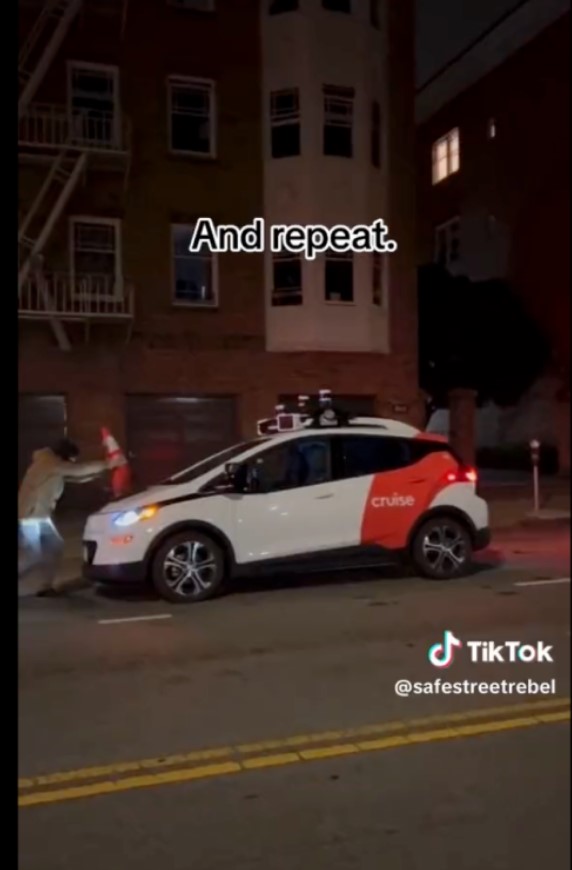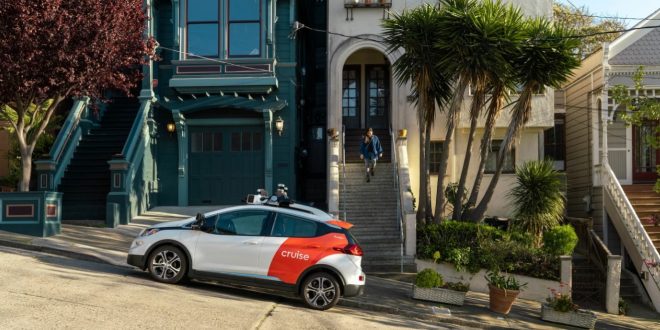San Francisco safe streets activists discovered they can disable Cruise and Waymo robotaxis by placing a traffic cone on a vehicle’s hood.
The group’s viral “Week of Cone” prank on Twitter and TikTok is a protest against the city’s robotaxi services, which residents are tired of breaking down and blocking traffic. The protest precedes a hearing where Waymo and Cruise may expand their robotaxi services in San Francisco.
On July 13, the California Public Utilities Commission (CPUC) will approve Cruise and Waymo’s San Francisco passenger service expansions. The DMV authorizes AV use on public roads, not the agency. However, it allows companies to charge passengers for that service, which is essential to scaling robotaxi and autonomous delivery operations sustainably.
Despite city agency and resident opposition, the CPUC posted draft resolutions approving the expansion in May. Opponents noted that AVs have hampered traffic, public transit, and emergency responders and urged the CPUC to move cautiously, hold workshops, collect more data, prohibit robotaxi deployment downtown and during peak hours, and limit fleet sizes.

The San Francisco Taxi Workers Alliance and the Alliance for Independent Workers have also opposed robotaxis, claiming they will eliminate taxi and ride-hail drivers.
Safe Street Rebel’s cone campaign aims to raise awareness and encourage more angry San Franciscans to submit CPUC comments before next week’s hearing.
“These companies promise their cars will reduce traffic and collisions, but instead they block buses, emergency vehicles and everyday traffic,” reads one social media video. They killed a person and a dog. They work with the police to record everyone without consent. Most importantly, they need car-friendly streets. They exist only to keep profit-driven car companies dominant and make transit harder to survive.”
Though exaggerated, the above statement contains truths. Cruise and Waymo vehicles have stopped on roads, blocking emergency, public transit, and general traffic. The Waymo AV that killed a dog was unavoidable. In 2018, an Uber self-driving vehicle killed a pedestrian in Arizona, but no AVs have killed anyone in San Francisco. Yes, Cruise and Waymo have helped the police solve a few crimes, but there’s no evidence that they’re recording everyone all the time.
However, the group raises a common concern about releasing autonomous vehicles onto public roads: the lack of input from people who actually use them. State transportation and motor vehicle departments regulate self-driving cars because Congress has lagged for years.
In response to the cone challenge, Harvard Kennedy School’s Taubman Center for State and Local Government visiting fellow David Zipper tweeted, “I see some tech bros wringing their hands in horror: ‘Won’t someone think of the AVs?!’”. “Strongly disagree. California regulators are making San Franciscans test AV tech. Protesting is acceptable.”
Another way:
Hell no. Safe Street Rebel objected.
The group suggests “gently placing” cones on a driverless car’s hood to disable it. It’s unclear how many people have submitted images to Safe Street Rebel. Request for comment was ignored.
Waymo called viral hacking vandalism.
“This is vandalism and encourages unsafe and disrespectful behavior on our roadways,” the company said. “We will report unsafe or unwanted vehicle interference on public roadways to law enforcement.”
Hyperbole again. Vandalism—slashed tires or broken windows—is intentional property damage. Someone who puts a cone on Waymo’s vehicles’ hoods probably won’t be charged with vandalism.
Cruise told that its autonomous driver had 73% fewer serious collisions than a human driver.
“Cruise’s fleet provides free rides to late-night service workers without more reliable transportation options, has delivered over 2 million meals to food insecure San Franciscans, and recovers food waste from local businesses,” Cruise said. “Intentionally obstructing vehicles hinders those efforts and risks local traffic congestion.”
Despite guerilla protests, the cone trick is unlikely to sway the CPUC. The CPUC can ignore dissent because elected officials, accessibility advocates, technology industry groups, and business and economic development organizations support it. According to the hearing agenda, the agency is ready to approve the program authorization.
An agenda item states that Cruise’s proposed service will not pose safety risks. Waymo follows suit.
 Tech Gadget Central Latest Tech News and Reviews
Tech Gadget Central Latest Tech News and Reviews




